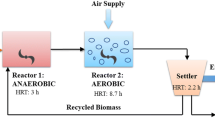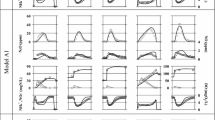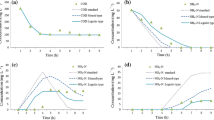Abstract
Nitrous oxide (N2O) is a greenhouse gas with a significant global warming potential. A dynamic model was developed to estimate the N2O production and emission in a full-scale sequencing batch reactor (SBR) municipal wastewater treatment plant (WWTP). Based on the Activated Sludge Model 1 (ASM1), the model considered all known biological and abiotic N2O production pathways along with the application of a ‘stripping effectivity’ (SE) coefficient for reflecting the non-ideality of the stripping model. N2O data of two different cycles (types B and C) were used for the model calibration. Cycle B involved the alternation amongst aerated and non-aerated phases, whereas cycle C included a unique long aerobic phase. Optimizing the dissolved oxygen (DO) and SE parameters for both cycles provided a good fit of the model (DO = 1.6 mg L−1 and SE = 0.11 for cycle B, and DO = 1.66 mg L−1 and SE = 0.11 for cycle C). In both cases, N2O emission peaks were related to high nitrite concentration in the liquid phase. Nitrifier denitrification was identified as the predominant biological pathway for N2O generation. Although SBR operation occurred at similar DO and SE values for both cycles, the emission factor was significantly different; 0.8% for cycle B and 1.5% for cycle C, indicating the impact of cycle configuration on the N2O emission. Thus, optimized SBR operation is essential in order to achieve a low overall carbon footprint through the avoidance of high N2O emissions and energy requirements.
Access provided by CONRICYT-eBooks. Download conference paper PDF
Similar content being viewed by others
Keywords
1 Introduction
Nitrous oxide (N2O) is a greenhouse gas (GHG) with a global warming potential 265 times higher than carbon dioxide in a 100-year period (IPCC 2013). During wastewater treatment, N2O production and emission is mostly observed during the biological nutrient removal (Pan et al. 2016). With such a significant greenhouse effect, the development of mathematical models estimating N2O dynamics emerges as an effective way to study the effect of operational conditions to decrease the carbon footprint in WWTPs. The implementation of these models will enable the establishment of mitigation strategies and, subsequently, optimal plant design and process control (Mannina et al. 2016; Pocquet et al. 2016; Massara et al. in press).
Three different biological pathways have been suggested for N2O production during the biological nitrogen (N) removal in wastewater treatment plants (WWTPs): nitrifier denitrification, incomplete hydroxylamine (NH2OH) oxidation and heterotrophic denitrification. The first two occur through the activity of Ammonia Oxidizing Bacteria (AOB) (Wunderlin et al. 2012). It is common practice to apply the IWA Activated Sludge Models (ASM) (Henze et al. 2000) for the description of biological chemical oxygen demand (COD) and nutrient removal in WWTPs. However, the original ASM models take no account of the N2O production and quantification. Hence, the aims of this work were: (i) to create an ASM-type model integrating the N2O dynamics for a full-scale municipal sequencing batch reactor (SBR) plant, and (ii) calibrate the developed model with real N2O emission data from the previous relevant study of Rodriguez-Caballero et al. (2015) (Table 1).
2 Materials and Methods
The model presented in this paper was based on the ASM1 (Henze et al. 2000) and was modified to include phosphate consumption by nitrifiers and heterotrophs. Afterwards, it was coupled with the two-pathway model of Pocquet et al. (2016) for N2O production by AOB. Moreover, the heterotrophic denitrification steps were imported from Hiatt and Grady (2008). Furthermore, recent studies have revealed that abiotic N2O production pathways can have a non-negligible contribution to the emissions during wastewater treatment (Harper et al. 2015; Soler-Jofra et al. 2016). For that reason, abiotic N2O production (i.e. NH2OH decomposition to N2O, and N-nitrosation of NH2OH with nitrous acid as nitrosating agent) (Domingo-Félez and Smets 2016) was also considered. Thus, the final model incorporated all the currently known pathways for N2O production.
The kinetic model was developed in MATLAB and implemented for an existing full-scale SBR performing COD and N removal in the municipal WWTP of La Roca del Valles (Barcelona, Spain) (48,000 population equivalents). Rodriguez-Caballero et al. (2015) examined different operational cycles to evaluate the effects on N2O production. They continuously monitored both gaseous and dissolved N2O using a gas analyzer and a microsensor, respectively, for 33 days between February and March 2014 corresponding to a total number of 143 cycles. Those measurements served for the calibration of the model presented in the current study.
Two different cycle types (type B and C) applied by Rodriguez-Caballero et al. (2015) for the same influent are presented in this abstract. They both began with a 10-min lag phase during which the mixed liquor was stirred before feeding started. Cycle B involved the alternation amongst two aerated (13–40 min) and two non-aerated phases (~25 min). The reaction phase for Cycle C included the sequence of two shorter non-aerated phases (~25 min) with a long aerated one (66 min) between them. Feeding was continuous. Details on the operational parameters and influent characteristics used in this work can be found in Rodriguez-Caballero et al. (2015).
N2O stripping was modeled by using the dissolved N2O concentration and the volumetric mass transfer coefficient (k L a) for N2O. We also included a ‘stripping effectivity’ (SE) coefficient expressing the non-ideality of this typical simplified model.
3 Results and Discussion
The total N2O emission (in g N-N2O d−1) for a cycle was an additional simulated variable. The evolution of this variable in time was used for calculating the instantaneous N2O emission. The results are given in Figs. 1 and 2 for cycle B and cycle C, respectively.
N2O emissions are expected to be negligible in the non-aerated phases due to the negligible stripping (Ahn et al. 2010). In accordance with this idea, both the experimental data and our model linked the emissions with air flow or, equivalently, with the aerated phases. Within the attempt to calibrate the model, the SE parameter was firstly evaluated. For both cycle types, a rather satisfactory fitting to the experimental N2O emission occurred under the same k L a modelling approach and SE value. It was noted that a SE equal to 0.11 contributed to a quite successful description of the experimental data in both cases, thus suggesting a clear influence of the stripping modeling on the final results.
According to the Global Water Research Coalition, the nitrification-related microbial routes (i.e. the two AOB pathways) are considered as major hotspots for N2O emissions in full-scale domestic WWTPs (GWRC et al. 2011). During nitrification, insufficient aeration has an inhibitory effect (Kampschreur et al. 2009), and can therefore lead to increased emissions through the AOB pathways. After the SE study, we explored the DO setpoint during the aerobic phases of each cycle as an important operational parameter. The results after the DO setpoint and SE optimization for cycles B and C are shown in Figs. 1 and 2, respectively. First, it can be seen that the simulation results are fitted well on the experimental ones. However, this version of the model with default kinetic parameters was unable to precisely capture the emission peak at the beginning of the 2nd aerated phase of Cycle B (Fig. 1); especially the part of the emissions noted at the very beginning of the peak. It can be hypothesized that these emissions were rapidly recorded as a result of the stripping of the N2O produced during the previous anoxic phase. This effect could be related to a N2O denitrification rate during the anoxic phase lower than the value predicted by the model, which could lead to a higher final N2O concentration at the end of the anoxic phase that would be stripped at the beginning of the aerobic phase. This divergence was not observed in cycle C because in this case only one aerobic phase existed. Specific experiments to evaluate N2O denitrification rate would help to improve the model fitting. Secondly, we received the following output of the optimization process: optimal DO = 1.6 mg L−1 and SE = 0.11 (cycle B), optimal DO = 1.66 mg L−1 and SE = 0.11 (cycle C). Both cycle types were applied for the same influent. The optimal fit occurred at similar DO setpoint and SE. However, the emission factor differed significantly, being 0.8% for cycle B and 1.5% for cycle C. This is probably attributed to the long aerated phase of cycle C which can be connected with the higher N2O emissions. As shown in Fig. 3 for both cycles, the N2O concentration peaks coincided with the nitrite (NO2 −) peaks in the liquid phase. This was observed for both the long aerobic phase of cycle C as well as for the 1st aerobic phase of cycle B; as mentioned above, the 2nd aerobic phase of cycle B was less successfully depicted in our simulations. Consequently, it can be deduced that nitrifier denitrification was the predominant AOB pathway for N2O generation. The optimal fit was obtained for a rather low DO setpoint (1.6 mg L−1 for cycle B and 1.66 mg L−1 for cycle C). This observation is in agreement with past studies regarding the AOB pathways relative contribution; compared to incomplete NH2OH oxidation, nitrifier denitrification has been suggested as increasingly contributing with the DO decrease (Anderson et al. 1993; Sutka et al. 2006; Kampschreur et al. 2008).
4 Conclusions
It can be concluded that the cycle configuration influences the emission magnitude. Long aerobic phases can increase the plant’s carbon footprint due to the following: (i) higher energy requirements, (ii) higher N2O production through the nitrification-related pathways, and (iii) subsequent N2O emission because of stripping. In this frame, process optimization is important. Optimal SBR operation includes the application of an optimal DO setpoint during aerobic phases of medium length. Under optimized SBR operation, satisfying nitrification along with moderate N2O emissions and reasonable energy requirements are more likely to be achieved. In that sense, the implementation of cycles with multiple (shorter) aerated phases (e.g. cycle B in this work) instead of cycle configurations with few and relatively long aeration periods (e.g. cycle C in this work) seems more suitable.
This work will hopefully constitute a flexible model for the prediction and mitigation of N2O emissions in full-scale SBR WWTPs with the added value of easily adapting to different cycle types.
References
Ahn JH, Kim S, Park H, Rahm B, Pagilla K, Chandran K (2010) N2O emissions from activated sludge processes, 2008–2009: results of a national monitoring survey in the United States. Environ Sci Technol 44:4505–4511
Anderson I, Poth M, Homstead J, Burdige D (1993) A comparison of NO and N2O nitrifier Alcaligenes faecalis. Appl Environ Microbiol 59:3525–3533
Domingo-Félez C, Smets BF (2016) A consilience model to describe N2O production during biological N removal. Environ. Sci. Water Res. Technol. 2:923–930
GWRC, Foley J, Yuan Z, Keller J, Senante E, Chandran K, Willis J, et al. (2011) N2O and CH4 emission from wastewater collection and treatment systems. Technical report, London, United Kingdom
Harper WF, Takeuchi Y, Riya S, Hosomi M, Terada A (2015) Novel abiotic reactions increase nitrous oxide production during partial nitrification: Modeling and experiments. Chem Eng J 281:1017–1023
Henze M, Gujer W, Mino T, van Loosdrecht M (2000) Activated Sludge Models ASM1, ASM2, ASM2d and ASM3. IWA Publishing, London
Hiatt WC, Grady CPL (2008) An updated process model for carbon oxidation, nitrification, and denitrification. Water Environ Res 80(11):2145–2156
Kampschreur MJ, Tan NCG, Kleerebezem R, Picioreanu C, Jetten MSM, van Loosdrecht MCM (2008) Effect of dynamic process conditions on nitrogen oxide emission from a nitrifying culture. Environ Sci Technol 42:429–435
Kampschreur MJ, Temmink H, Kleerebezem R, Jetten MSM, van Loosdrecht MCM (2009) Nitrous oxide emission during wastewater treatment. Water Res 43:4093–4103
IPCC (2013) The final draft report, dated 7th June 2013, of the Working Group I contribution to the IPCC 5th Assessment Report. In: Climate change 2013: the physical science basis. www.climatechange2013.org/report/review-drafts/
Mannina G, Ekama G, Caniani D, Cosenza A, Esposito G, Gori R, Garrido-baserba M, Rosso D, Olsson G (2016) Greenhouse gases from wastewater treatment - a review of modelling tools. Sci Total Environ 551–552:254–270
Massara TM, Malamis S, Guisasola A, Baeza JA, Noutsopoulos C, Katsou E (in press) A review on nitrous oxide (N2O) emissions during biological nutrient removal from municipal wastewater and sludge reject water. Sci Total Environ
Pan Y, van den Akker B, Ye L, Ni B-J, Watts S, Reid K, Yuan Z (2016) Unravelling the spatial variation of nitrous oxide emissions from a step-feed plug-flow full scale wastewater treatment plant. Sci Rep 6:20792
Pocquet M, Wu Z, Queinnec I, Sperandio M (2016) A two pathway model for N2O emissions by ammonium oxidizing bacteria supported by the NO/N2O variation. Water Res 88:948–959
Rodriguez-Caballero A, Aymerich I, Marques R, Poch M, Pijuan M (2015) Minimizing N2O emissions and carbon footprint on a full-scale activated sludge sequencing batch reactor. Water Res 71:1–10
Soler-Jofra A, Stevens B, Hoekstra M, Picioreanu C, Sorokin D, van Loosdrecht MCM, Perez J (2016) Importance of abiotic hydroxylamine conversion on nitrous oxide emissions during nitritation of reject water. Chem Eng J 287:720–726
Sutka RL, Ostrom NE, Ostrom PH, Breznak JA, Gandhi H, Pitt AJ, Li F (2006) Distinguishing nitrous oxide production from nitrification and denitrification on the basis of isotopomer abundances. Appl Environ Microbiol 72:638–644
Wunderlin P, Mohn J, Joss A, Emmenegger L, Siegrist H (2012) Mechanisms of N2O production in biological wastewater treatment under nitrifying and denitrifying conditions. Water Res 46:1027–1037
Acknowledgments
T.M. Massara is grateful to the Natural Environment Research Council (NERC) of the UK for the 4-year full PhD studentship. Her PhD research is additionally supported and funded by the European Union Research Program C-FOOT-CTRL (H2020-MSCA-RISE-2014, Grant agreement no: 645769). J.A. Baeza and A. Guisasola are members of the GENOCOV research group (Grup de Recerca Consolidat de la Generalitat de Catalunya, 2014 SGR 1255). E. Katsou and J.A. Baeza are members of EU COST Action Water_2020.
Author information
Authors and Affiliations
Corresponding author
Editor information
Editors and Affiliations
Rights and permissions
Copyright information
© 2017 Springer International Publishing AG
About this paper
Cite this paper
Massara, T.M., Katsou, E., Guisasola, A., Rodriguez-Caballero, A., Pijuan, M., Baeza, J.A. (2017). Modeling of N2O Emissions in a Full-Scale Activated Sludge Sequencing Batch Reactor. In: Mannina, G. (eds) Frontiers in Wastewater Treatment and Modelling. FICWTM 2017. Lecture Notes in Civil Engineering , vol 4. Springer, Cham. https://doi.org/10.1007/978-3-319-58421-8_15
Download citation
DOI: https://doi.org/10.1007/978-3-319-58421-8_15
Published:
Publisher Name: Springer, Cham
Print ISBN: 978-3-319-58420-1
Online ISBN: 978-3-319-58421-8
eBook Packages: EngineeringEngineering (R0)







